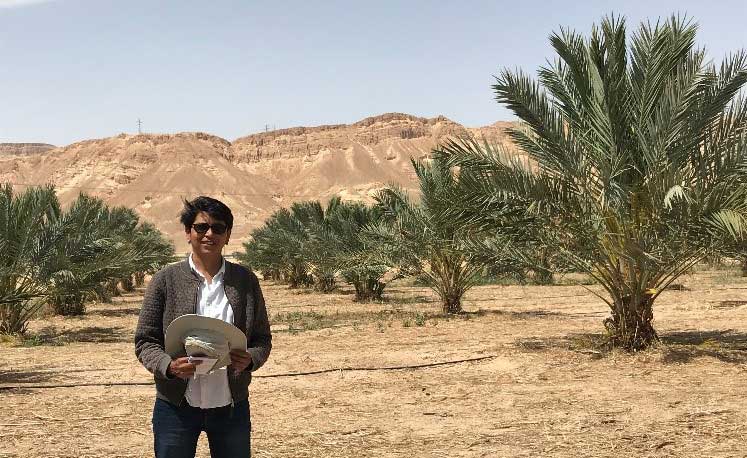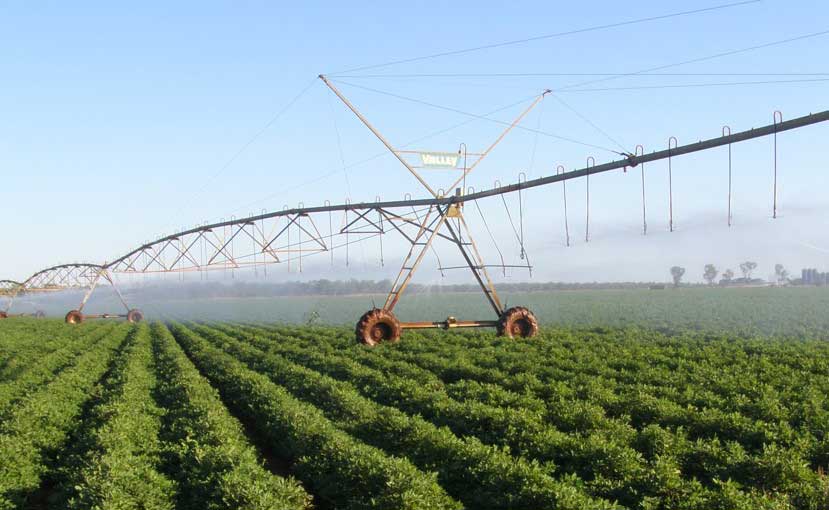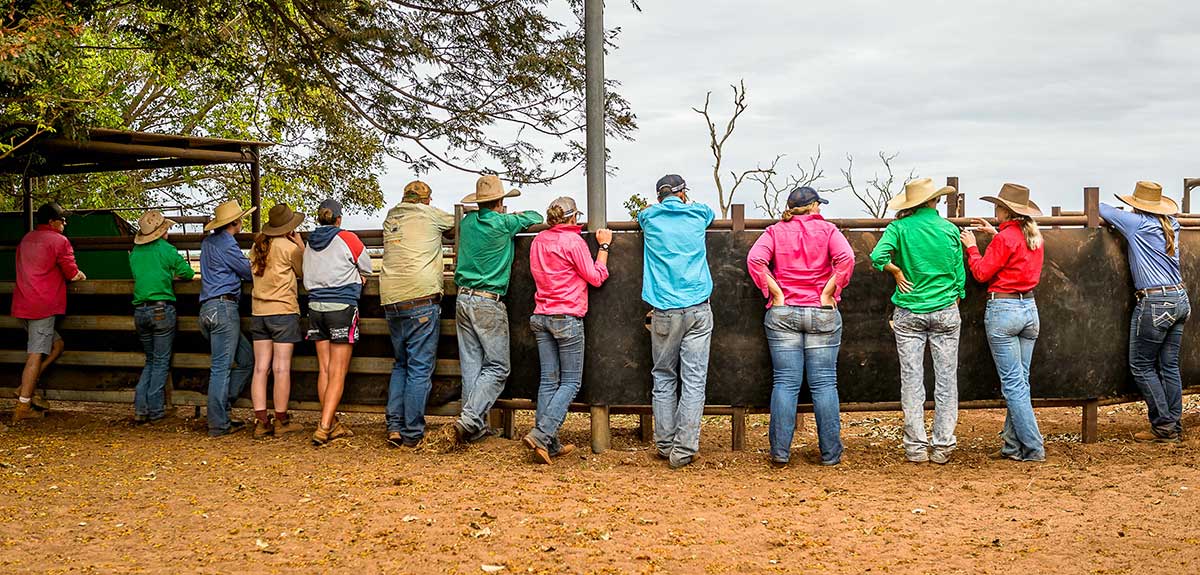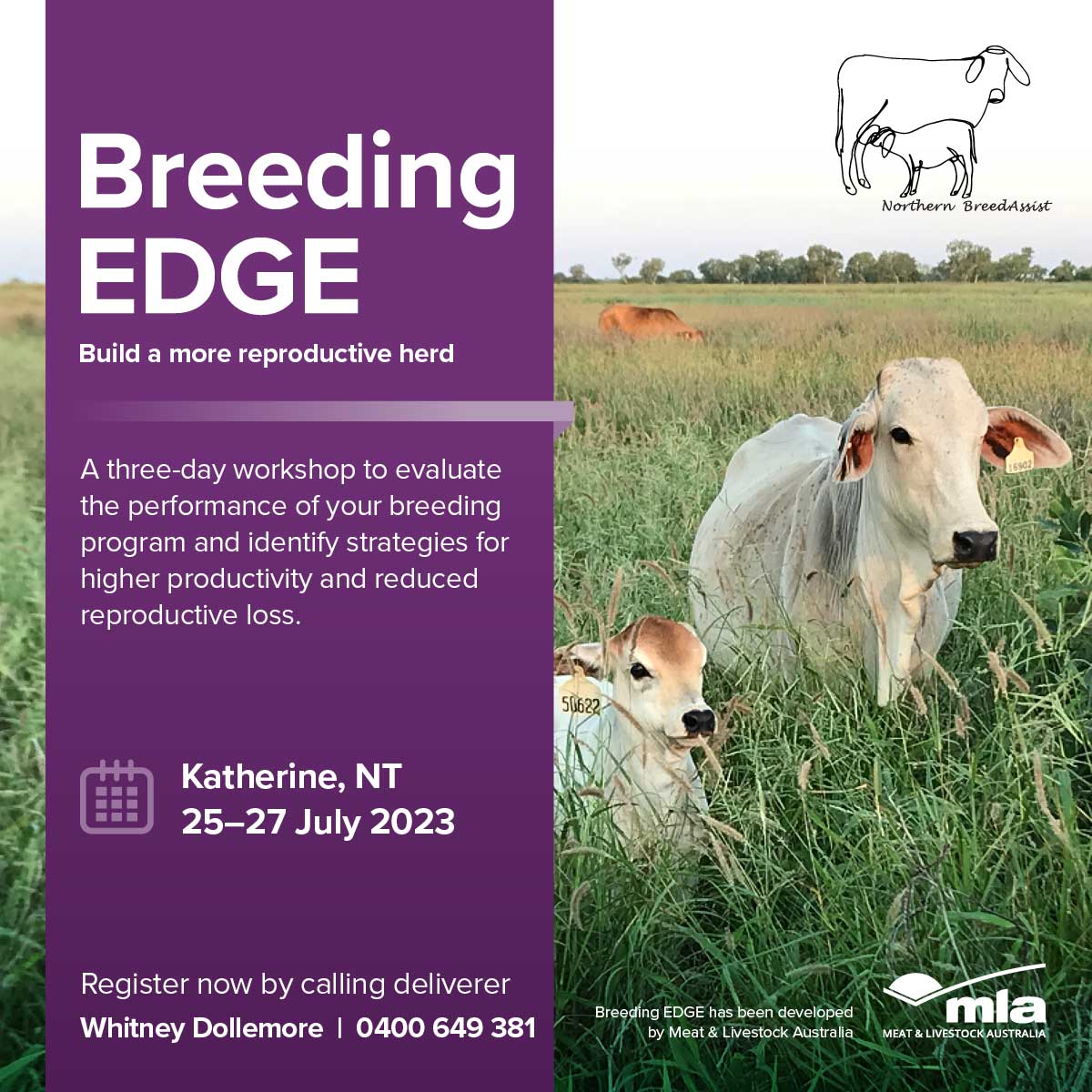Agriculture and Biosecurity newsletter: May 2023
Welcome to the Agriculture and Biosecurity newsletter for May 2023.
Boost for Red Centre with growth opportunities for date industry

Although not widely known, the date palm thrives in the arid climate of the Red Centre. This emerging sector in Australia, particularly in the Territory has had a recent boost with Dr Girija Page, a Senior Research Horticulturist in the Northern Territory (NT) returning with new learnings from an industry capacity building tour.
Dr Girija Page, who is a Senior Research Horticulturist for the Department of Industry, Tourism and Trade, was selected to travel with 2 date growers, Mr Shaun O’ Connor, a date grower from the NT and Mr Gary Doak, a date grower from Queensland on an overseas expedition to India, UAE, Jordan and Israel.
This industry capacity building tour was funded by AgriFutures Australia’s Emerging Industries Program and was in collaboration with the Australian Date Growers Association (ADGA). The tour provided the trio with invaluable experience, gaining skills and knowledge while engaging with specialists and visiting world-renowned facilities to assist with boosting the date industry in Australia.
The tour gave insight on the importance of utilising the correct crop, the implication of water management techniques and provided further understanding of succession planting including identification and eradication of ‘non-performing palms’. Connecting with growers in different climates and visiting state of the art facilities both, organic and conventional, has aided the group to establish informed decision-making plans for Australian growers on the various ways to manage date orchards that best suit their needs and build the date industry on home soil.
The tour highlighted the generally high cost of production of dates in Australia as a potential impediment to competing in global date markets. The high level of mechanisation used in date cultivation in Israel identified the economies of scale Australia needs to achieve if it were to compete in global markets by going hi-tech and capital intensive to lower the cost of production. This reinforced the importance of maintaining the Australian market with quality and locally produced dates.
Another key takeaway was the significant and valuable role of our strict border control measures and the importance of biosecurity in Australia.
The insights gained will be shared with other date growers and relevant stakeholders through the ADGA network to help move towards sustainable and profitable growth of the small and emerging date industry in Australia.
International plant health day

The United Nations has declared 12 May as the International Day of Plant Health. This national day raises awareness about the importance of healthy plants for our ecosystem. Plant health is a key requirement of the sustainable development of agriculture maintaining biodiversity. To find out more or get involved, go to the Plant Health Australia website.
2023 Northern Australia Food Futures Conference

The department is working with industry to develop a strategy to increase the sector’s contribution to the Northern Territory economy, from the current $1.3 billion economic contribution to a targeted $2 billion by 2030.
This conference is scheduled to take place in Darwin Convention Centre from Tuesday 23 May 23 to Thursday 25 May 2023.
To learn more about this work, come and chat to our team at this year’s Food Futures conference. To register, go the Northern Australia Food Futures Conference website.
You can also check out the Northern Australia Food Futures podcast which is an 8 part series exploring the 2023 conference theme, ‘Northern Myths, Realities and Opportunities’.
What makes station staff stick around?

You pay well, provide good accommodation, wiFi and days off. What else can you offer? What do employees want? How do you encourage them to stay longer?
A high staff turnover is a known issue in the northern beef industry. There have been numerous articles published and presentations on the topic over the last 10 years, as well as Nuffield Scholar, Tammy Kruckow, choosing to focus her study program on successful staff retention strategies.
So we asked 15 past and current employees, including ringers, headstockpersons, managers and recruiters from a mix of cattle stations and companies across the Northern Territory (NT) for their thoughts.
Here’s what they said:
What makes employees leave
“I have plans to move stations… mainly due to flaws in the management system.”
– first year ringer
Without sugar-coating it, a lot of responses to ‘what makes employees leave?’ revolved around management. We asked employees and here is some of what they said:
“In some circumstances there was a very old-fashioned mentality of what a tough outback boss-worker relationship would be…treating workers with a lot of disrespect, which would not be tolerated in most other workplaces in Australia” - ex-ringer.
“My manager has a habit of bullying people to get the outcome he wants… he attacks people’s capabilities rather than seeing that they want to learn and pulling them up to teach them in an appropriate manner” - first year ringer.
“Ringers are set up to fail to learn” – recruiter.
“Too many promises broken and too much expectation placed on new staff” - ringer, 6 years in industry.
“…don’t often see deep enough into people and processes that are providing value” - ringer, 5 years in industry.
It goes without saying, bad management is not the norm on every station, but in the eyes of employees we heard from, some managers are the reason for failing staff retention.
“People are still blaming the new generation for problems with recruitment and staff retention, instead of being the leaders they should be and working with [the changes].”
- recruiter
Fortunately, this means that a small shift in the approach taken by managers could have a positive effect on staff retention. People management is a hot topic and expectations are higher on managers to lead by example. Good people management skills is fundamental in staff retention, regardless of the industry.
There were also plenty of comments around management of the experience employees receive and the environment they work in, such as ‘lack of career satisfaction or opportunities for growth’ and ‘toxic station culture’.
“I was constantly given the same jobs and not able to progress… my work wasn’t recognised” - ex-ringer, still in industry.
“Not going anywhere in my role from year to year, a negative, unhappy atmosphere in the workplace… lack of communication/trust in the workplace, strained relationship with management” - contractor.
“We fall short in areas where I would like to expand my learning… it is harder to learn as there is less opportunity for a beginner to have a go” - first year ringer.
“Manager’s lack of willingness to accept change or for headstockmen to make a difference” - ex-headstockperson.
“The management isn’t inclusive, not supporting of teamwork or responsibility” - ex-ringer.
It didn’t go unnoticed that there is a generational shift which may be impacting staff retention, and some factors which managers might not have much say in.
“People used to stay forever, new generation has freedom, choice and it’s easier to move”
- recruiter.
“Animal husbandry things, I don’t understand how some companies can earn so much money yet are tight with feeding lick or hay to the animals” - headstockperson.
“Hard to go further in this company due to not many spots opening up” - headstockperson.
“Inexperienced people are getting pushed into management roles” - ex-headstockperson.
“Close living environment… no space to yourself” - ex-ringer.
“Always wanted to head south after I’d had enough of station life… saw better working conditions and pay down south” - ex-ringer.
“I left to go to uni, nothing was changing my mind… there’s no reason I wouldn’t go back to working for that company” - ex-ringer, still in industry.
“Not getting along with other staff members, feeling isolated and feeling pressures from home to go back home” - manager.
While we have listed some things that are not controllable by stations and managers, positive feedback included the importance of strong mentorship, managers leading by example and small incentives that can improve employee longevity.
What makes employees want to stay
Some common themes can definitely be noted.
“They care how you make them feel.”
- ex-headstockperson, still in industry
Before mentioning pay or accommodation, almost everyone said that employees want to feel valued.
“When you have manager that values their staff and continually expresses their gratitude… it is much more encouraging for staff to want to do better, try harder and keep coming back” – ringer.
There were many comments revolving around being heard, having hard work recognised, feeling appreciated and ‘an enjoyable workplace where everyone feels valuable in their role and a part of the team!’.
“The recognition of my work and my improvement is what made me go back” - ex-ringer, still in industry.
Station culture plays a big role in how employees feel. Employees want ‘a safe working environment where people feel they can learn and grow’, ‘a culture in which they strive to do a good job’ and ‘an atmosphere where they feel like they are a part of a great team which feels like a family’.
In short, employees seek an inclusive culture that is fun, safe and supportive.
So how do you achieve this?
Good people management
Good management is integral to staff retention. Specifically, people management and communication.
“There is a shortage of people up here with actual people management skills.”
- ex-headstockperson
So what aspects of people management are employees after?
“Transparent and open communication” - recruiter and ex-ringer.
“Set people up to learn and succeed” – recruiter.
“Transparent with plans for the business” - ex-headstockperson, still in industry.
“A good relationship with the boss who communicates well with everyone” – contractor.
“Managers and companies that can communicate clearly and openly with their staff… have a much more positive atmosphere” – ringer.
“Treat everyone with respect and fairly” - manager.
“Treat staff as equals rather than operating under a hierarchy” - ex-ringer, still in industry.
“A lack of communication and transparency was frustrating and made it hard to show initiative” - ex-ringer, still in industry.
It seems that good, open communication is a theme here.
An approach one employer is using to improve their people management is identifying different personalities within their crew so that they can better understand and communicate with them.
“Some people take longer to develop a relationship with the role they are in. I feel as though we need to identify what standard we require from our staff, the traits that are required for these standards… throughout a 6 month window” – manager.
“Treat them fairly and how you would like your kids to be treated if they were out working on a station.”
- contractor.
‘The majority of the people we see filter through these stations are so young’. ‘They don’t want to be just a number in the books’, and they aren’t. They are young people here for the experience, to learn and to start their careers.
“People have still come up for the experience so why not teach them as much as you can?” – headstockperson.
“Working as a ‘family of friends’ encourages people to show up for each other” - ex-headstockperson, still in industry.
“Businesses that tend to retain good people have managers that show empathy” - ex-headstockperson.
Responsibility, opportunity and career progression
“When I look at employment opportunities, I find that my decisions revolve largely around responsibility and career opportunities.”
- ringer
Given that having responsibility is a key factor in feeling valued, it’s no surprise that this and ‘opportunity’ were mentioned a lot.
“Give them some responsibility so that they can feel like they are good at what they do” – contractor.
“Opportunity to learn and grow is extremely key in making myself and a lot of other workers stay in the workplace” - first year ringer.
“Offer staff the chance to expand their knowledge through different forms of learning- whether it be shoeing, livestock handling or business management schools- this can be a great incentive for staff to stick around” – ringer.
The lack of opportunity for career progression is a major trend we noted for a reason why staff leave stations. Similarly, ‘staff promotions, whether it’s on the station they are on or within-company transfers to show them there is potential to make a career in the industry’ was listed as a reason to stick around.
But how do you know which staff to invest in?
“As long as they are keen and willing to learn, I’ll give them any time of the day to teach them” – headstockperson.
“Good management will work to bring everyone up, not just a specific few” - ringer, 4 years in industry.
“I believe everyone should be given equal opportunity for training and growth opportunities if they show interest or curiosity” - ex-ringer, still in industry.
“Investment into the training of staff members is crucial and a risk we need to take to hopefully spark a fuse to make staff want to stay involved” - manager.
Pay, accommodation and benefits
“Make sure your rates are competitive with others in the industry. If you can’t pay as much as someone else you can offer something else to make up for it.”
- contractor
Pay and accommodation were also brought up, but they didn’t rank as highly as you might think.
“Money isn’t everything but when you’re working from daylight to dark and the work is rarely ever easy, it would be nice to be paid your worth” – headstockperson.
“Competitive wages and good facilities for staff to live in” – headstockperson.
“How well they pay. For a station or company to be competitive, I would chase decent pay or extra benefits” - ex-ringer, still in industry.
As for what benefits station staff are looking for, it doesn’t appear to be a one size fits all. Here’s what some people suggested:
“Small little bonuses, like people with working dogs - the company paying for a couple bags of dog feed” - headstockperson.
“Letting staff use station horses to compete and vehicles to transport horses to campdrafts” - headstockperson.
“Having your own horses or dogs, freedom to use station facilities etc” - ex-ringer, still in industry.
“A station that feels like home- where I am comfortable to do my own thing without feeling like I am intruding on someone else’s property.”
- ex-ringer, still in industry
After all, if someone is going to stick around for a while, that station is their home.
Whether the feedback gathered here has given you some things to work on, or if you’re pretty happy with your people management as it is, do you know what would make your best workers stay on for a couple more years? Asking the question, listening and giving employees a chance to share their thoughts might be the first step in helping improve staff retention on your property and in the industry as a whole.
Resources:
Recruitment: Staff retention should be top of managers' priority list - Beef Central
Recruitment: Attracting and retaining quality staff in extensive northern beef - Beef Central
Cattle station managers and trainers offer tips on finding staff and keeping them - Beef Central
Large-scale-employers-attracting-and-retaining-staff-in-the-pastoral-livestock-industry.pdf (futurebeef.com.au)
Lead with Certainty workshop- Tammy Kruckow Coaching: Tammy Kruckow Coaching | Facebook
Douglas Daly round up

Around 55 producers, industry representatives, Northern Territory (NT) Government researchers and extension staff came together in early April at Douglas Daly Research Farm (DDRF) for a field day with a focus of discussions around sustainability, research updates and integration of mixed farming in the Northern Beef Industry.
Rotational cropping potential investigated
The day began at the DDRF cotton trials with presentations from Department of Industry, Tourism and Trade (DITT) Cropping Group Leader, Edward Mwando, Principal Entomologist Brian Thistleton, and discussions on crop management with Nick Hartley and Peter Shotton.
Edward discussed the cotton establishment and rotational trials at Douglas Daly, Katherine Research Station, and other nearby commercial properties. Trials at DDRF in 3 paddocks involve planting forage as a rotational crops with sequence: cotton - corn; cotton - sorghum; and cotton - cavalcade. A fourth paddock offers continuous cotton planting. These were all planted in January and will be monitored throughout the crop cycle. The aim of these trials are to see what rotational systems work best in this environment and to investigate the potential of integrating cropping and grazing.
Entomology a major focus due to fall army worm burden
Brian Thistleton spoke about the use of integrated pest management (IPM) in the cotton trials at DDRF. Some of the main IPM principles followed for pest control are:
- Only spraying when necessary, to avoid chemical active ingredient resistances and to minimise impact on beneficial bugs.
- Bollguard cotton - bollguard contains the genes to express toxins to prevent the heliothis and different species of spodoptera from eating the cotton bolls. The toxin genes aren’t expressed through the flowers so there may still be some damage to flowers but this is not generally an indication of boll damage.
- Biological control - swamping the environment with artificial female pheromones (disrupted mating) preventing males from finding the females.
- Using a refuge crop such as pigeon pea - the susceptible pests in this population mate with resistant populations in the crop and reduce the number of resistant pests.
Local producers discuss trials and tribulations of dryland cotton management
The cotton theme continued at local producer Sam McBean’s property where some of the challenges of cotton in the Douglas Daly region were discussed. Crop management, plant and soil pathology, and the introduction of the cotton myBMP were key topics.
Rotationally grazing gamba a win-win tool for previously unproductive land
The group visited the DDRF gamba trial, where gamba grass is successfully managed by rotational grazing. Gamba grass has spread through the northern NT and the spread must be controlled. Gamba grass is quite palatable in its early growth stages so can be grazed reasonably heavily to prevent it reaching its later growth stages where fire hazard becomes a serious issue. As well as successfully controlling the height and spread of gamba, rotationally grazing resulted in average daily gains of around 0.65kg.
'Crops for Cattle'- analysing benefits of supplementary feeding
Principal Livestock Researcher, Tim Schatz went on to discuss the upcoming project ‘Crops for Cattle’, a collaboration with the CRCNA. The project aims to foster the integration of cropping and cattle systems by utilising pre-existing and new grain feeding programs to increase dry season weight gains on NT properties and to quantify the production and economic cost/benefits. Another facet of this project is to investigate the potential for carbon credits. An increased weight gain over the dry season would mean a faster turnover of cattle and less methane produced in the animal’s lifetime.
Buffalo fly tag trials prove effective in comparison to control group
DITT has collaborated with Y-Tex to investigate the effectiveness of insecticidal ear tags in the Top End. Cattle at DDRF that were given buffalo fly tags had an average weight gain 17kg higher in 25 weeks than cattle that did not have fly tags. DITT is also working with Y-Tex at Beatrice Hill Farm to develop tags with new insecticide agents to combat development of resistance in insect populations.
Leucaena proving a unique and hardy grazing forage
Bron Christensen, CEO of The Leucaena Network, presented information and management strategies from Leucaena trials and the benefits and challenges that come with establishment. Peter Shotton also spoke about the DDRF Leucaena trials, which we then drove out to see.
Select herds targeting high fertility to increase production
DITT livestock researcher Gretel Bailey-Preston spoke about the DITT selected Brahman and composite herds and the journey to increase herd fertility through selection. She explained the management strategies and use of EBVs (estimated breeding values).
The department breeds around 200 composite and Brahman bulls each year, and after ranking them by their weight, scrotal size, percent normal sperm and dam performance, the top 24 animals with high EBVs in these areas are retained to produce progeny. The rest of the bulls that meet temperament, performance and confrontation criteria are sold at the annual DITT bull sale, to provide the industry with high performing sires that are adapted to NT conditions.
Producers were interested in knowing what the breed percentages of the composite cattle were when they started at a set composition in the early 2000s (56.3% Brahman, 12.5% Africander, 12.5% Tuli, 6.3% Shorthorn, 6.3% Charolais and 6.3% Hereford) and how they have evolved with selection.
Combatting low fertility through increased EBV accuracies
Gretel Bailey-Preston spoke about the Repronomics II project which is a collaboration with the University of New England’s Animal Genetics and Breeding Unit (AGBU). The project aims to combat low fertility in northern cattle herds through increasing the rate of progress of selection for fertility. This is being done through increasing the accuracy of fertility EBVs, improving our ability to identify the most fertile animals, and developing across breed EBVs. Through testing for the onset of puberty in yearling heifers, and the time to resume cycling after calving, the aim is ultimately to decrease the anoestrous period and potentially increase the number of calves weaned per lifetime. The Repronomics I project (the predecessor to the current project), increased the accuracy of the days to calving EBV by 18% with the full range of traits the target for the Repronomics II project.
Producer engagement key to industry future
An open discussion moderated by Senior Executive Director of Agriculture, Phil Hausler to finish for the day. The questions were answered by relevant industry personnel and Phil also turned the microphone back to producers to gauge their industry positions and opinions on a number of issues, with future research needs the predominant topic.
The team extends their thanks to all producers, industry representatives and NT Government staff for showing support on the day. Special thanks go to the organisers, speakers, project partners and funding bodies, and drink sponsors Nutrien Ag Solutions.
Breeding EDGE workshop

The department is proud to support ‘Breeding EDGE’, a 3‑day workshop created by MLA in coordination with Australian Cattle Veterinarians and Northern BreedAssist. This workshop is designed to assist producers improve and refine herd management and provide in-depth reproductive knowledge and technologies to achieve desired production targets for cattle owners.
This conference will be held in Katherine from 25 to 27 July 2023 and places are limited.
For more information contact Whitney Dollemore on 0400 649 381 or email whitney@nthbreedassist.com.
Give feedback about this page.
Share this page:
URL copied!